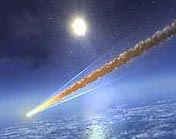 Contrary to popular belief, "falling stars"
are not stars at all, but are meteors,
solid bodies that travel through space. Contrary to popular belief, "falling stars"
are not stars at all, but are meteors,
solid bodies that travel through space.
Meteors, ranging in size from that of a pinhead, to many tons, are visible to the
naked eye at night, when the friction between the surfaces of the
meteors and of the air, produces heat as the meteors enter the
earth's atmosphere. The intense heat
incinerates the meteors, which leave a blazing trail of light
in their wake.
Most meteors do burn up when they enter the earth's atmosphere,
with the exception of the large meteors, which are dragged through
the earth's atmosphere by the earth's gravitational pull. After
successful landings upon the earth, these huge bodies are renamed
meteorites. Some scientists theorize
that thousands of meteors fall to the earth during the daytime and
the nighttime, but this theory is impossible to prove or to
disprove, as most would necessarily land in water, which covers most
of the earth's surface.
Generally speaking, meteors and meteor particles travel together
in swarms like bees, with the exception of the loners, and travel in
any direction they choose. Nature's spectacular fireworks show, a
"meteor shower," comes into view when
the swarms encounter the upper layer of the earth's atmosphere
during the earth's perpetual revolution around the sun. The friction
produced when the meteors and the meteor particles rub against the
atmospheric air incinerates the swarms, and they fall towards the
earth in a brilliant display of light.
The source of meteors traveling through space has yet to be
explained satisfactorily. For thousands of years, the common belief
held, was that meteors, or "falling stars," were literally from out
of this world. In 467 BC, Roman historians recorded the
extraordinary fall of a meteor to the earth.
Today, astronomers espouse the
theory that comets spawn the swarms. The comets' offspring, the
meteor swarms, travel in regular orbits, similar to the earth's
orbit around the sun. One must be quite patient to witness such a
swarm, or a meteor shower, as the swarms cross the earth's path only
once every 33 years. This spectacle of light is, however, well worth
the wait.
|
|
note:
|
meteor: 流星
pinhead: 针头,小东西
incinerate: 把……烧成灰烬
meteorite: 陨石
meteor shower: 流星雨
espouse: 支持,赞成 | |